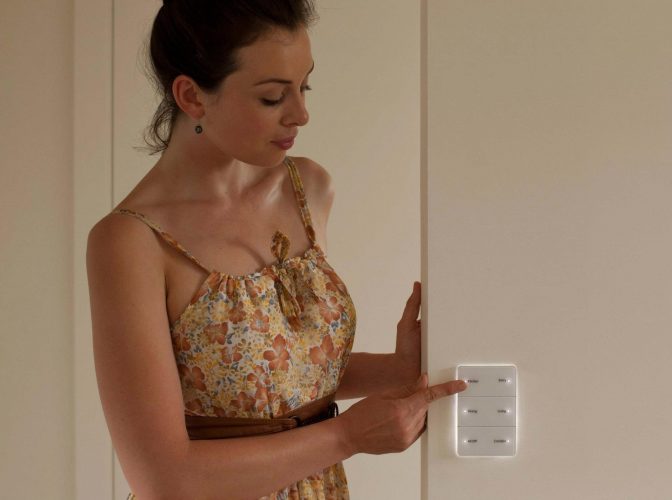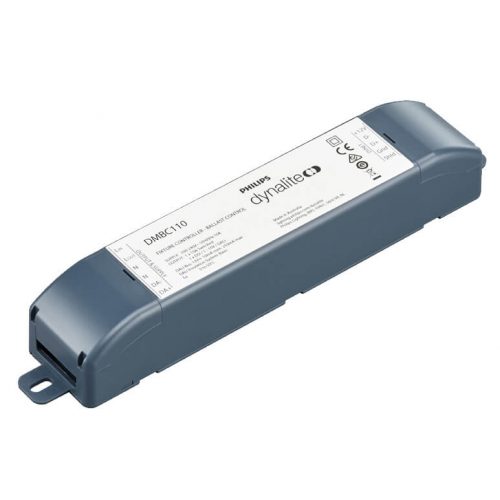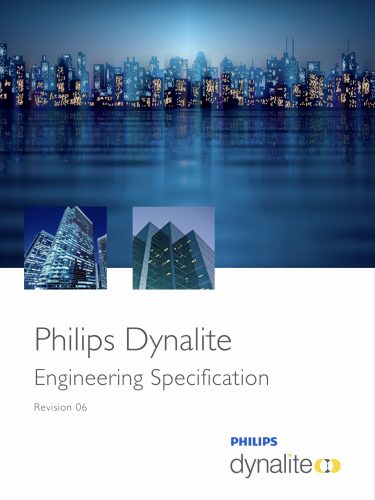
The Philips Dynalite AntumbraButton user interface consists of easy to press mechanical buttons that can be customized with text or icons and incorporates the latest in field effect technology. The contemporary design features a number of button configurations, with each button capable of local or site-wide control functions.
- Field effect technology – The user interface detects an approaching user and ‘wakes up’, initiating a wall-wash lighting effect to encourage interaction.
- Supplied as two components – The Application Module contains buttons, rim, base and mounting plate, which can be mixed and matched to suit décor. The Communication Module contains all of the logical and network functions and is pre-programmed off-site, allowing commissioning to commence prior to finish options being finalized.
- Hidden sensory inputs – An internal light sensor measures ambient light and adjusts lightwash effect accordingly. A built-in temperature sensor automatically adjusts air conditioning when integrated into the system.
- Multiple language and icon labeling – Button labeling language choices include English, Chinese and Arabic. A library of common icons transcends language barriers, which is particularly useful in hospitality applications.
- Selection of rim and fascia options – Allows décor matching to suit any environment.
Specification Sheet
Installation Instructions
Button configurations
For The Australian market, the Antumbra Button series is available with three different button configurations; 2/4/6 buttons. The base button application module is the same on all models, with the buttons easily attached and removed if required.
- PA2BPA
- PA4BPA
- PA6BPA

Product codes
When ordering, there is a suffix added to the standard product code that specifies finish options:
- Button finish
- Rim finish
- Labelling

Button colour/finish
Antumbra is now available with a range of finishes, to suit any decor. The traditional plastic (polycarbonate) button finishes are now complimented by a range of stunning metallic finishes.
Polycarbonate finishes (Plastic)
W = White
S = Silver
M = Magnesium
Metallic finishes
A = Aluminium
G = Gold
J = Jet
N = Noir
P = Prestige
V = Vintage

Rim finish
The Antumbra range can be ordered with a mix of rim finishes to compliment the button finish. Rims are plastic, with the aluminium and chrome being a metallic look, rather than being metal.
W = White
A = Aluminium
C = Chrome
M = Magnesium

Custom labelling
Custom labelling has always been a feature of Dynalite user interfaces. I recommend and encourage all user interfaces to be labelled to improve the user experience for the client.
X = No labels (blank)
L = Custom labels
Use the online Philips Antumbra configurator to produce labelling documentation, to sign off on, and accompany your purchase order.
Pricing
When reviewing the Philips Dynalite price list, pricing Antumbra panels can be a little confusing.
- All button configurations are the same price (i.e. 2/4/6 buttons).
- All rim colours are the same price (when included with the panel).
- Button finish pricing varies, between polycarbonate and metallic.
- All Antumbra panels require a DACM communications modules, that is ordered as a separate product.
- All panels should be labelled where possible – it provides the best user experience (but you can order unlabelled if you want).
The most popular and typical pricing configurations of a labelled polycarbonate and metallic panels are:
- PAxBPA with labelled polycarbonate buttons (W/S/M) + DACM
- PAxBPA with labelled metallic buttons (A/G/N/J/V/P) + DACM
Can’t commit to labelling?
It is quite common for some clients to order unlabelled Antumbra panels, and an additional labelled button set.
When ordering a button set, be sure to prepare configuration documentation using a PAxBSA product code, rather that a standard PAxBPA code.
Pricing this scenario could look something like this example:
- PAxBPA with unlabelled polycarbonate buttons (W/S/M) + DACM
- PAxBSA labelled polycarbonate button set
More functionality?
If 2,4, or 6 buttons is not enough, and you require more functionality, look at the Antumbra Display range, that I will feature in an upcoming ‘Getting to know’.
This series of articles focuses on products from the Philips Dynalite networked lighting control portfolio. Many industry professionals regard Philips Dynalite as being the world’s best lighting control system, that I have represented with Lightmoves for many years. SimonLakey







